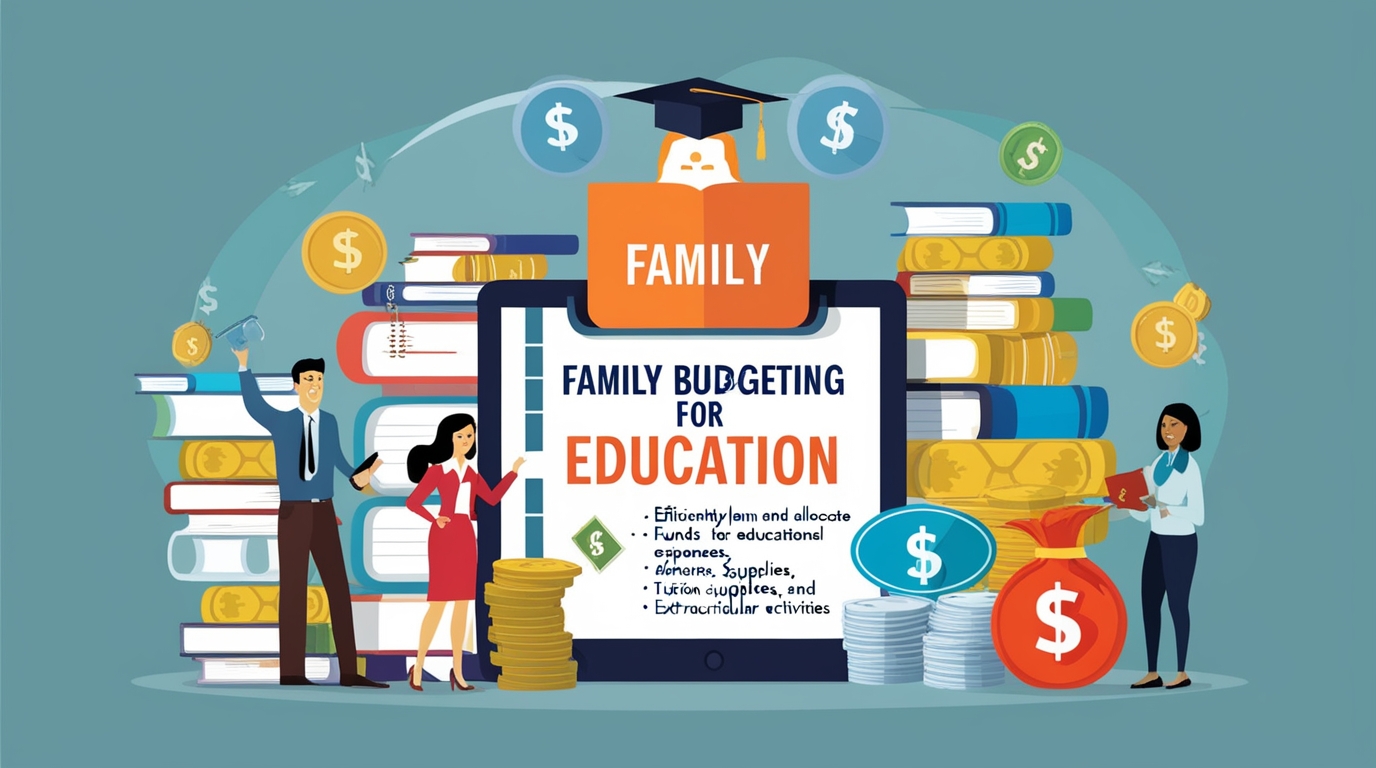Family Budgeting for Education: Ensuring Financial Stability and Academic Success
Family Budgeting for Education is a significant investment for any family. From preschool to university, the costs associated with schooling can be substantial. Effective family budgeting for education is crucial to ensuring that these expenses are manageable and do not compromise the family’s overall financial stability. This article explores the importance of budgeting for education, strategies for creating a robust educational budget, and practical tips for managing educational expenses at various stages.
The Importance of Family Budgeting for Education
Family budgeting for education is essential for several reasons:
- Financial Preparedness: Anticipating and planning for educational expenses helps families avoid financial surprises and debt.
- Prioritizing Education: Budgeting ensures that education remains a financial priority, reinforcing its importance to the family’s future.
- Stress Reduction: A well-planned budget can reduce financial stress, allowing families to focus more on supporting their children’s academic and personal development.
- Goal Setting: Budgeting helps families set and achieve educational goals, such as saving for college or funding extracurricular activities.

Creating an Effective Educational Budget
Creating a comprehensive educational budget involves several steps:
- Assess Current Financial Situation: Start by evaluating your current financial situation. This includes understanding your income, expenses, debts, and savings. Knowing your financial baseline is crucial for realistic budgeting.
- Identify Educational Expenses: List all potential educational expenses. These can include:
- Tuition and Fees: Costs for public or private schools, colleges, and universities.
- Supplies and Materials: Books, uniforms, stationery, and other necessary supplies.
- Transportation: Costs associated with getting to and from school, such as bus fares, car expenses, or public transportation.
- Extracurricular Activities: Fees for sports, music lessons, clubs, and other activities.
- Technology: Expenses for computers, tablets, software, and internet access.
- Living Expenses: For college students, this includes accommodation, food, and other living costs.
- Set Financial Goals: Determine your short-term and long-term educational financial goals. Short-term goals might include saving for next semester’s tuition, while long-term goals could involve building a college fund.
- Create a Savings Plan: Based on your financial assessment and goals, create a savings plan. Determine how much money you need to set aside each month to meet your educational goals. Consider using dedicated savings accounts or educational savings plans, such as 529 plans in the United States.
- Monitor and Adjust: Regularly review your budget to track progress and make adjustments as needed. Life circumstances and educational costs can change, so flexibility is important.
Strategies for Managing Educational Expenses
Effective management of educational expenses requires a combination of planning, resourcefulness, and financial discipline. Here are some strategies to help manage these costs:
- Explore Financial Aid and Scholarships: Research and apply for financial aid, scholarships, and grants. Many institutions and organizations offer financial support based on need, merit, or specific criteria. This can significantly reduce the financial burden.
- Utilize Tax Benefits: Take advantage of tax benefits available for educational expenses. In some countries, there are tax deductions, credits, or tax-advantaged savings plans specifically designed to support education.
- Consider Community Resources: Look for community resources and programs that offer free or low-cost educational support. Libraries, community centers, and non-profit organizations often provide valuable resources and programs.
- Buy Used or Rent Textbooks: Purchasing used textbooks or renting them can save a considerable amount of money compared to buying new ones. Many online platforms offer these options.
- Plan for Technology Needs: With the increasing importance of technology in education, plan for technology expenses in your budget. Look for deals, discounts, and second-hand options to reduce costs.
- Limit Extracurricular Costs: While extracurricular activities are important, they can also be expensive. Limit the number of activities your child participates in, or seek out less costly alternatives. Community-based programs often offer similar benefits at a lower cost.
- Encourage Part-Time Work: For older students, part-time work can help cover some educational expenses. It also teaches valuable financial responsibility and time management skills.

Budgeting for Different Educational Stages
Educational expenses vary significantly at different stages of a child’s academic journey. Here’s how to approach budgeting for each stage:
- Early Childhood Education: Early childhood education, including preschool, can be expensive. Research affordable options, such as community preschools or cooperative programs. Consider the long-term benefits of early education and budget accordingly.
- Elementary and Secondary Education: Public schooling is typically less expensive than private schooling. However, additional costs such as supplies, extracurricular activities, and transportation need to be accounted for. Budget for these recurring expenses and look for ways to save, such as bulk-buying supplies.
- College and University: Higher education is often the most significant financial commitment. Start saving early through dedicated education savings plans. Research colleges and universities to find ones that fit both academic and financial criteria. Consider in-state versus out-of-state tuition, and explore financial aid options thoroughly.
Practical Tips for Family Budgeting for Education
- Involve the Whole Family: Make budgeting a family activity. Involve children in discussions about financial goals and the importance of budgeting for education. This teaches them valuable financial literacy skills.
- Automate Savings: Set up automatic transfers to your education savings account. This ensures consistent savings without the temptation to skip contributions.
- Track Expenses: Use budgeting apps or spreadsheets to track educational expenses. Regular monitoring helps you stay on track and adjust as needed.
- Prioritize Emergency Savings: In addition to saving for education, maintain an emergency fund. Unexpected expenses can arise, and having a safety net ensures that your education budget remains intact.
- Review and Adjust Annually: Educational needs and expenses can change over time. Review your budget annually and adjust based on changes in income, educational costs, or family goals.
- Seek Professional Advice: Consider consulting a financial advisor, especially if you’re planning for significant educational expenses like college. They can provide tailored advice and strategies to optimize your savings and budgeting efforts.
Conclusion
Family budgeting for education is a proactive approach to managing one of the most significant financial commitments a family can face. By planning ahead, setting realistic goals, and utilizing available resources, families can ensure that educational expenses are manageable and do not compromise financial stability. Education is a crucial investment in a child’s future, and with careful budgeting, families can support their children’s academic journey while maintaining overall financial health.

j0hjmk
Pretty! This was a really wonderful post. Thank you for your provided information.
fvggy3
pwvzq3
I’d have to examine with you here. Which is not one thing I usually do! I take pleasure in reading a post that may make folks think. Additionally, thanks for permitting me to comment!
I?¦ve recently started a website, the info you offer on this website has helped me greatly. Thanks for all of your time & work.
I would like to thank you for the efforts you have put in writing this website. I’m hoping the same high-grade blog post from you in the upcoming also. Actually your creative writing abilities has inspired me to get my own site now. Really the blogging is spreading its wings quickly. Your write up is a great example of it.
whoah this blog is excellent i love reading your articles. Keep up the good work! You know, many people are searching around for this info, you can aid them greatly.
I as well think hence, perfectly pent post! .
Thanks for the post, can you make it so I get an email every time you make a fresh post?
Very interesting info!Perfect just what I was looking for!
Hello.This article was really interesting, especially since I was searching for thoughts on this issue last Wednesday.
I am not very superb with English but I come up this rattling easygoing to interpret.
I’ve recently started a blog, the info you offer on this web site has helped me tremendously. Thanks for all of your time & work.
hello!,I like your writing so much! share we communicate more about your article on AOL? I need a specialist on this area to solve my problem. Maybe that’s you! Looking forward to see you.
Great site! I am loving it!! Will be back later to read some more. I am taking your feeds also.
Hi there! This is kind of off topic but I need some guidance from an established blog. Is it very difficult to set up your own blog? I’m not very techincal but I can figure things out pretty quick. I’m thinking about making my own but I’m not sure where to begin. Do you have any points or suggestions? Thanks
When I originally commented I clicked the -Notify me when new comments are added- checkbox and now each time a comment is added I get four emails with the same comment. Is there any way you can remove me from that service? Thanks!
You really make it seem really easy along with your presentation but I find this topic to be actually one thing that I think I’d by no means understand. It sort of feels too complex and extremely vast for me. I’m having a look ahead in your subsequent submit, I’ll try to get the grasp of it!
Your style is so unique compared to many other people. Thank you for publishing when you have the opportunity,Guess I will just make this bookmarked.2
You have noted very interesting details! ps decent site. “Enemies, as well as lovers, come to resemble each other over a period of time.” by Sydney Harris.
Good write-up, I am normal visitor of one?¦s web site, maintain up the excellent operate, and It’s going to be a regular visitor for a long time.